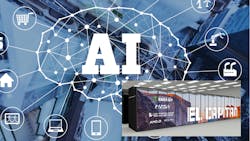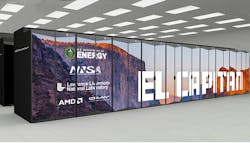Lawrence Livermore Plans World’s Fastest Computer: El Capitan
Engineers and managers at Lawrence Livermore National Lab (LLNL) will be partnering with their counterparts at Hewlett Packard Enterprises (HPE) and Advanced Micro Devices Inc. (AMD) to build El Capitan, predicted to be the world’s fastest supercomputer when it is competed in 2023. Its primary mission, according to the lab, will be keeping the nation’s nuclear stockpile safe, secure and reliable by performing complex and increasingly predictive modeling and simulation for the National Nuclear Security Administration’s (NNSA) Life Extension Programs (LEP), which address weapons aging and potential threats in the absence of underground nuclear testing.
The newest supercomputer will be powered by next-generation EPYC processors, code-named “Genoa.” The processors feature the “Zen 4” processor core, next-generation Radeon Instinct GPUs based on a new architecture for workloads (including high-power computing and artificial intelligence) and the Radeon Open Compute platform heterogenous software, all from AMD. The nodes will support simulations used by NNSA to address the demands of the LEPs, which have growing computational requirements due to stockpile modernization efforts and in response to changing threats from America’s adversaries.
The supercomputer’s GPUs are said to provide enormous computation capability for the energy used and they will provide most of the machine’s peak floating-point performance. This will let users run high-resolution 3D models quicker, as well as increase the fidelity and repeatability of calculations, thus making those simulations truer to life.
Expected to be one of the most capable supercomputers in the world, El Capitan will have a significantly greater per-node capability than any current supercomputer. Its graphics processors will be well-suited for AI and machine-learning-assisted data analysis. This is further proof LLNL is making a major move into AI-driven scientific workloads. These workloads will supplement models that researchers hope will be faster, more accurate and capable of quantifying uncertainty in their predictions. This is useful for maintaining the nuclear stockpile.
El Capitan also will have many features not yet widely used, including HPE’s advanced Cray Slingshot interconnect network, which will let it carry out large calculations across many nodes, an essential requirement for the NNSA’ simulations. In addition, HPE and LLNL will explore electrical-to-optical interfaces that could deliver higher data transmission at faster speeds with improved power efficiency and reliability. El Capitan will also run Cray’s Shasta software platform, which will have a container-based architecture that lets administrators and developers be more productive. Sandia and Oak Ridge National Labs will also participate in the overall program.
Besides supporting the nuclear stockpile, El Capitan will be used to in nuclear nonproliferation and counterterrorism efforts. On the civilian side, it will likely be used on NNSA’s unclassified projects such as climate modeling and cancer research.

